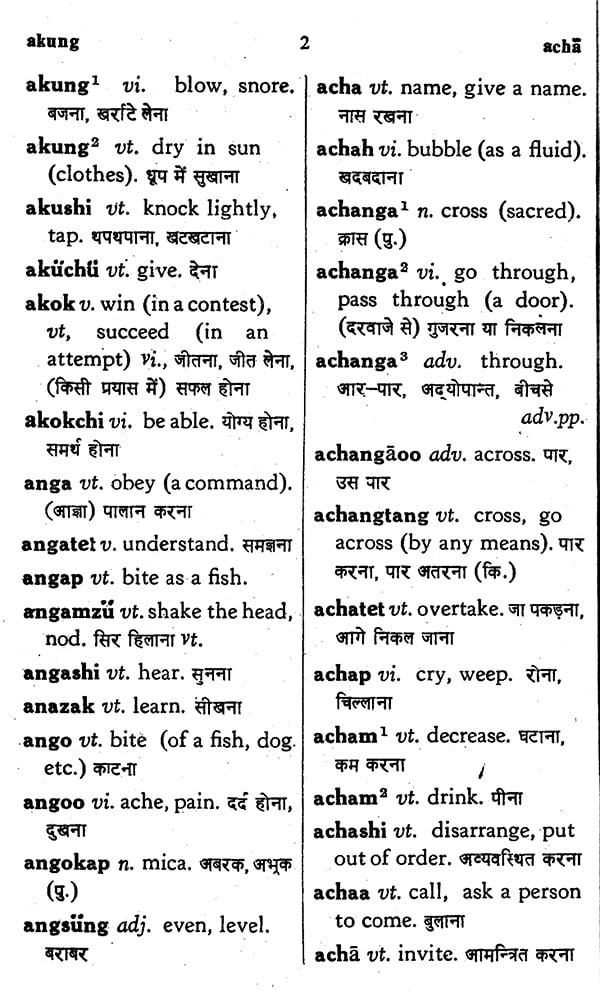
AO-English-Hindi Dictionary
Book Specification
| Item Code: | NAX402 |
| Author: | K.S. Gurubasave Godwa |
| Publisher: | Central Institute Of Indian Languages, Mysore |
| Language: | AO Hindi and English |
| Edition: | 1987 |
| Pages: | 80 |
| Cover: | PAPERBACK |
| Other Details | 7.00 X 5.00 inch |
| Weight | 100 gm |
Book Description
Tribal developments in the country has been vitiated due to presuppositions. It is generally taken for granted that tribals are in the periphery of Indian society and outside the Indian psyche. It is also assumed that the tribals need protection and they must be integrated into the Indian main stream. Scholars and administrators alike believed in the 19th century that the tribals either had no language or had limited languages. It was said for example that So:ra language had only 700 words. The term ‘culture of silence’ came in handy to reinforce the above notion. - Tribal languages are neither easy nor are they incomplete. Structurally they are as complex as the known major languages of India. They express all the nuances of tribal life and are capable of expressing any aspect of modern life if put to such use. The Central Institute of Indian languages which has a major programme of studying tribal languages in all their psycho-social relations, has decided to produce a grammar, a dictionary, a volume of folklore and learning: materials for.children and adults in each language with a view to establishing bi-directional communication among the tribal and non-tribal communities.
providing Hindi and English glosses an attempt has been made to simultaneously expose the Ao speakers to both the official and associate official languages of the country. We hope that the non-Ao speakers who will have occasion to come in contact with them either for administrative or for trade purposes will find the dictionary useful.
Our field workers who have worked under difficult conditions and produced such materials as this deserve commendation, I also put on record our appreciation for those who are responsible for the speedy execution of the work.
The present Ao-English-Hindi Dictionary is the first to be published in our dictionary series.
The tribal people in India have for long lived in isolation except to be exposed for exploitation. They have not participated to their benefit in the socio- economic development of the country. To come out of their isolation, it is necessary for them to learn the language of the majority people around them and a number of them have done so. But this bridges the communication gap only in one way and the. whole burden of building up this bridge is carried by the minority group. It is necessary, however, for developings, mutual understanding and good-will, to increase bidirectional communication between the tribal people and the majority of people of the region. For this purpose, the majority people, especially those who come in contact with the tribal people for various reasons such as civil administration, security, social service, trade, etc., should learn their language. The dictionary, which forms part of the package consisting of phonetic reader, grammar and instructional materials, is prepared to help them in their learning of the tribal language.
The preparation of a dictionary in a tribal language is an important step for the codification of the language. Keeping this in- view the entry in the tribal lauguage is given in the script suggested for it. It is followed by phonemic transcription to aid pronuncia tion when the script isnot based on Roman. The meanings are given in the language of the State where the tribal language is spoken and in English and where ever possible, also in Hindi. This will help the literate tribal: people in their learning these languages. The dictionary is followed by appendices of special lexical classes in the language in some cases.
Though the dictionary is meant to be helpful for language learning, it is hoped that it will also be useful to linguists. The grammatical labels are based on the grammar of the language prepared in the Institute. Data for the dictionary were collected in the field primarily from oneinformant by elicitation through the word list prepared in the Institute. They were then cross-checked with some other informants. The list of words may not be exhaustive and we are trying to evolve methods to increase the words. Comments and suggestions passed on to us will be useful to improve our future publication in this series.









